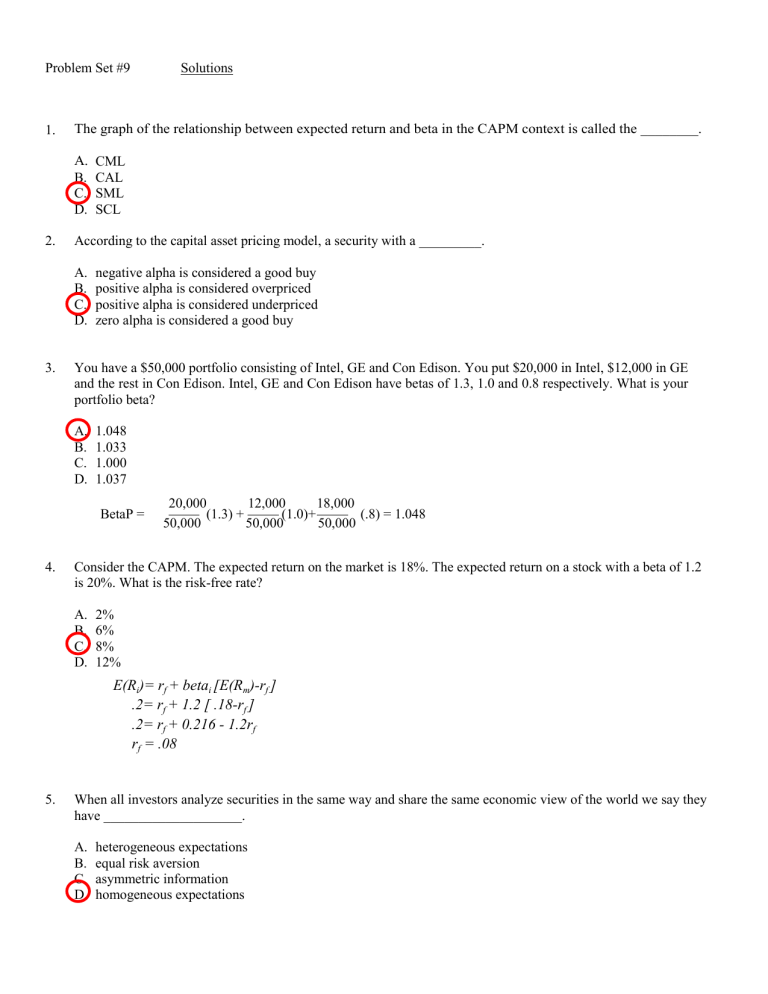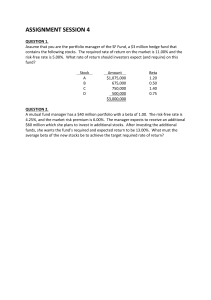
Problem Set #9
1.
The graph of the relationship between expected return and beta in the CAPM context is called the ________.
A.
B.
C.
D.
2.
CML
CAL
SML
SCL
According to the capital asset pricing model, a security with a _________.
A.
B.
C.
D.
3.
Solutions
negative alpha is considered a good buy
positive alpha is considered overpriced
positive alpha is considered underpriced
zero alpha is considered a good buy
You have a $50,000 portfolio consisting of Intel, GE and Con Edison. You put $20,000 in Intel, $12,000 in GE
and the rest in Con Edison. Intel, GE and Con Edison have betas of 1.3, 1.0 and 0.8 respectively. What is your
portfolio beta?
A.
B.
C.
D.
1.048
1.033
1.000
1.037
20,000
12,000
18,000
BetaP =+++{======
(1.3) +
(1.0)+
(.8) = 1.048
50,000
50,000
50,000
4.
Consider the CAPM. The expected return on the market is 18%. The expected return on a stock with a beta of 1.2
is 20%. What is the risk-free rate?
A.
B.
C.
D.
2%
6%
8%
12%
E(Ri)= rf + betai [E(Rm)-rf ]
.2= rf + 1.2 [ .18-rf ]
.2= rf + 0.216 - 1.2rf
rf = .08
5.
When all investors analyze securities in the same way and share the same economic view of the world we say they
have ____________________.
A.
B.
C.
D.
heterogeneous expectations
equal risk aversion
asymmetric information
homogeneous expectations
6.
Consider the following two stocks, A and B. Stock A has an expected return of 10% and a beta of 1.20. Stock B
has an expected return of 14% and a beta of 1.80. The expected market rate of return is 9% and the risk-free rate is
5%. Security __________ would be considered a good buy because _________.
A.
B.
C.
D.
A, it offers an expected excess return of 0.2%
A, it offers an expected excess return of 2.2%
B, it offers an expected excess return of 1.8%
B, it offers an expected return of 2.4%
Using the CAPM
7.
Consider the multi-factor APT with two factors. Portfolio A has a beta of 0.5 on factor 1 and a beta of 1.25 on
factor 2. The risk premiums on the factors 1 and 2 portfolios are 1% and 7% respectively. The risk-free rate of
return is 7%. The expected return on portfolio A is __________ if no arbitrage opportunities exist.
A.
B.
C.
D.
8.
13.5%
15.0%
16.25%
23.0%
The expected return on the market portfolio is 15%. The risk-free rate is 8%. The expected return on SDA Corp.
common stock is 16%. The beta of SDA Corp. common stock is 1.25. Within the context of the capital asset
pricing model, _________.
A.
B.
C.
D.
SDA Corp. stock is underpriced
SDA Corp. stock is fairly priced
SDA Corp. stock's alpha is -0.75%
SDA Corp. stock alpha is 0.75%


